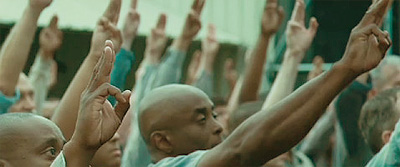I love the beginning of a new school year - new faces, new challenges, and a chance to start fresh.
One of my favorite beginning of year activities allows students to express how they feel about math using objects. It gives me a chance to get to know their feelings towards math, and also gives some insight into their ability to create figurative language. I also get a chance to share a bit about myself.
Here is how I introduce this activity.
I have the class in a circle and explain that my daughter used to play with lots of different items. I then pull out this ratty lunchbag. It is, I explain, her lunchbox from when she started pre-school when she turned three. In this bag I have some items she also used to play with when she was about three years old. I shake the bag and ask, "What are some things you think might be in here?"
legit - it is her lunch bag from preschool!
I get guesses from dolls and ponies to legos to crayons... It's a nice variety. I then dump the contents in the center of the circle.
Students always are amazed at the variety of things in the bag. They also then ask about how old she is now, if I have other children, and suddenly we are connecting on a personal level. They bring up connections with the objects (I had a Mr. Potato Head! Does that Silly Putty thing really have putty in it? (it does) awww, that's a cute Littlest Pet Shop!)
The great bag of everything
After I give them time to observe, I bring it back to math. I tell them people have lots of different feelings about math. Some people love math and some don't enjoy it. All of those feelings are ok - you don't have to love math, and in fact it could be your least favorite thing.
I then ask them to look at the objects and find one that you think of when you think of math - how you feel about math, what you think of math, what math means to you...
Students get some think time, get a thumbs up ready, and choose a student to start. That student then picks the direction the circle will travel. I explain that everyone will share, but I also give students the opportunity to pass if they aren't ready on their turn. When a student goes, they take the object from the center, return to their chair and explain why they chose it. Here are some quotes from my 6th grade class this week:
- "For me math is like a weight - when I get a math problem it feels like a weight is being put on me."
- "Math is like the Rubic's cube piece. I always get jumbled up and think there is no way to solve the problem."
- "Math is like the multi-colored pen. There are lots of ways to solve it like there are lots of colors."
- "For me it is like the battery because I need lots of energy and when I get something right it recharges me, but if I get it wrong I feel like a dead battery."
I have found the key to this lesson, like so many others, is not in the activity itself but the culture setting and story telling before hand. This is a great 2nd day of school activity after students have gotten to know each other and me a bit. Just as important is the lead up. Building that curiosity about the bag, having students talk about the objects, and making those personal connections makes it easier for them to share later in the activity. It isn't enough just to get the students in a circle and dump a bag in front of them - they need the whole experience!
I've also accepted this challenge put forth by @Aaron_Hogan. So far I've learned I have students that
I've also accepted this challenge put forth by @Aaron_Hogan. So far I've learned I have students that
- Play soccer, swim, and dive.
- Make their own mermaid tails that are usable in the water.
- Enjoy farming and made a model tractor using donuts.
- Do not like candy or cake!
- Have 11 pets including 3 dogs and 3 cats.
Go learn something amazing about your students!





























.jpg)












